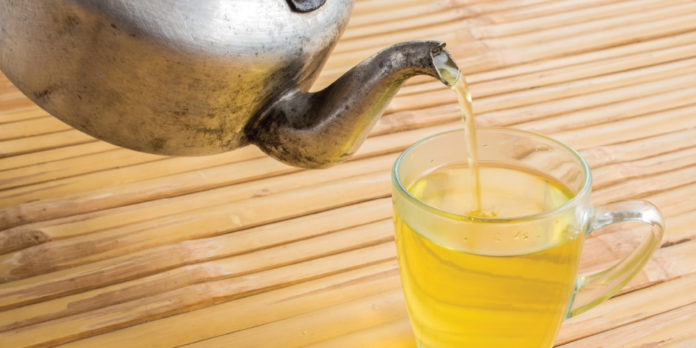The UK is a nation of tea-lovers but the teas we love are changing. Shireen Khalil finds out what a new generation of young, health-conscious consumers are drinking.
The UK remains the land of tea-lovers, despite a drop in consumption. Whether it’s helping kick-start the day or getting you through the afternoon lull, it’s a hot beverage that still warrants its hefty share of shelf space.
There is an opportunity for tea brands to expand and sales to increase, with new flavours key to this.
Over the past four years, green tea and herbal teas have seen their combined share of the tea category grow by 6% to around 30% of the market, with 16-to-34-year-olds spearheading this growth.
Nevertheless, black tea is still key. Helen Boulter, channel controller at Taylors of Harrogate, says: “Although the range of products in the tea market has exploded with a host of new flavours over the past few years, black tea with milk is still the nation’s favourite brew. So we would always recommend that a wholesaler’s offering includes the traditional black tea, like our much-loved Yorkshire Tea or premium Yorkshire Gold.”
Standard’s falling
David Rich, channel business manager for UK & Ireland at tea manufacturer Twinings, confirms that there has been a decline in tea sales in recent years, which is largely driven by deep-cut price discounting on standard tea.
“This has rewarded loyal drinkers rather than bringing new shoppers into the category,” Rich says. “In the convenience retail channel, tea is worth £33m annually, although it is experiencing an annual decline of almost 10% that’s driven largely by the weak performance of standard tea.
“However, the out-of-home (OOH) opportunity continues to provide growth, with £3.4bn in tea sales across the different channels in the past year.”
Rich predicts growth both in and out of home will come from premium teas, such as speciality, green and infusions, which are more suited to changing consumer tastes and attract a younger audience.
As consumers become increasingly health-conscious, Rich notes, they tend to look for proactive ways to incorporate healthier options into their diet; drinking green tea and fruit infusions is recognised as a way of achieving this.
Taylors of Harrogate has given its herbal range new, bright, artistic packaging, as well as creating exciting and innovative new blends and green tea ranges. The four new blends have been created in partnership with botanical experts at Royal Botanic Gardens, Kew, and in line with flavour trends. The blends include a Mandarin & Ginger infusion, which adds a twist to the popular citrus and ginger combination, and Green Tea blended with Lychee & Lime, White Hibiscus & Peach and Mango & Cardamom.
Meanwhile, Tetley’s envelope range includes blends with natural and intense fruity flavours such as Tetley Green Tea with Mango. Marshall Kingston, senior brand manager at Tetley, says fruit and herbal blends are growing by 5.6% and 2.5%, respectively. By promoting their health benefits, operators can tap into the current market trend and continue to drive sales – making them a must-stock for wholesalers.
To enable wholesalers to further promote their ranges to customers, Tetley suggests blocking brands and arranging bestselling ones together.
“Displaying different teas in a logical sequence also allows for easy navigation of what’s on offer,” Kingston says. “Ensure you stock a range of sizes and formats specifically for caterers, including the three growing segments: green, fruit & herbal, and speciality tea.”
Most major brands are catering to consumers’ organic wants by expanding their ranges. Clipper Teas has recently dedicated major investment into converting its green tea range to be fully organic and Fairtrade, to further align with the brand’s natural and ethical credentials.
Adele Ward, brand controller at Wessanen UK, which owns Clipper Teas, says that with consumers seeking organic products, Clipper is well placed to help retailers meet this demand, by also expanding its pack size.
“We are looking to increase our largest pack size in Organic and Fairtrade Everyday Tea – this has grown from an 80-bag pack to a 100-bag pack to meet the needs of consumers stocking up in one big shop rather than making smaller impulse trips,” she says.
She adds: “An increasing number of consumers are using their local independent shops to buy bigger-sized packs. Considering that black teas represent a large proportion of hot beverage sales for independents, retailers can increase their rate of sale by adding bigger packs to their range.”
With range rationalisation, it can be hard for a retailer to know which varieties of tea to stock and the brands it should prioritise. But Ward agrees that retailers should stock a diverse range. “It is essential to have the right balance of black tea, including organic English Breakfast, Fairtrade, Earl Grey and decaf, to suit a variety of shoppers’ needs,” she says.
Taylors’ Boulter reiterates the importance of stocking decaf options. “Decaf is becoming more popular as people continue to look for healthier alternatives,” she says. “Yorkshire Tea Decaf doesn’t compromise on the well-known and much-loved taste or quality, so Yorkshire Tea lovers needn’t miss out on their favourite brew.”
Boulter adds that wholesalers should consider smaller pack sizes: “When working with wholesalers, we always recommend they pay close attention to listings – we feel stocking smaller pack sizes such as 40s and 80s offers lower pricemarks and great value.”
Chocolate treats
There’s still room in your hot beverages range to cater for those who have a sweet tooth. Susan Nash, trade communications manager at Mondelez, says the drinking chocolate category has room for growth, as only one in two households buys hot chocolate: “It’s highly popular in the OOH market thanks to the rise of the café culture,” she notes.
Mondelez has continued to innovate in this sector, with new products such as Cadbury Freddo Drinking Chocolate, which the company launched last year in an attempt to help reconnect families with hot chocolate.








